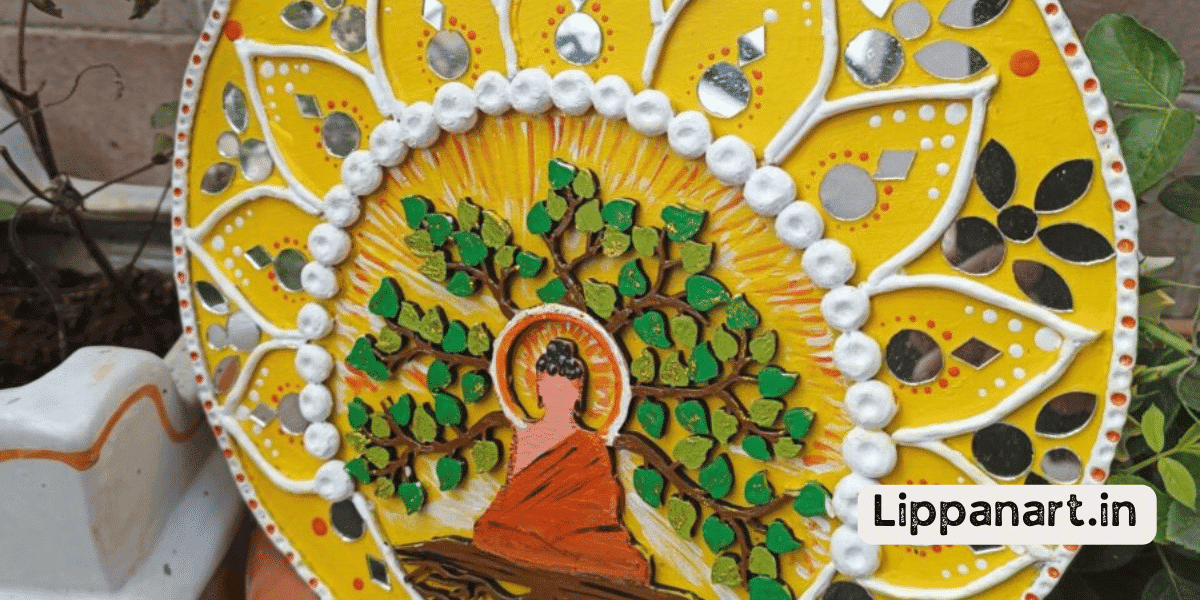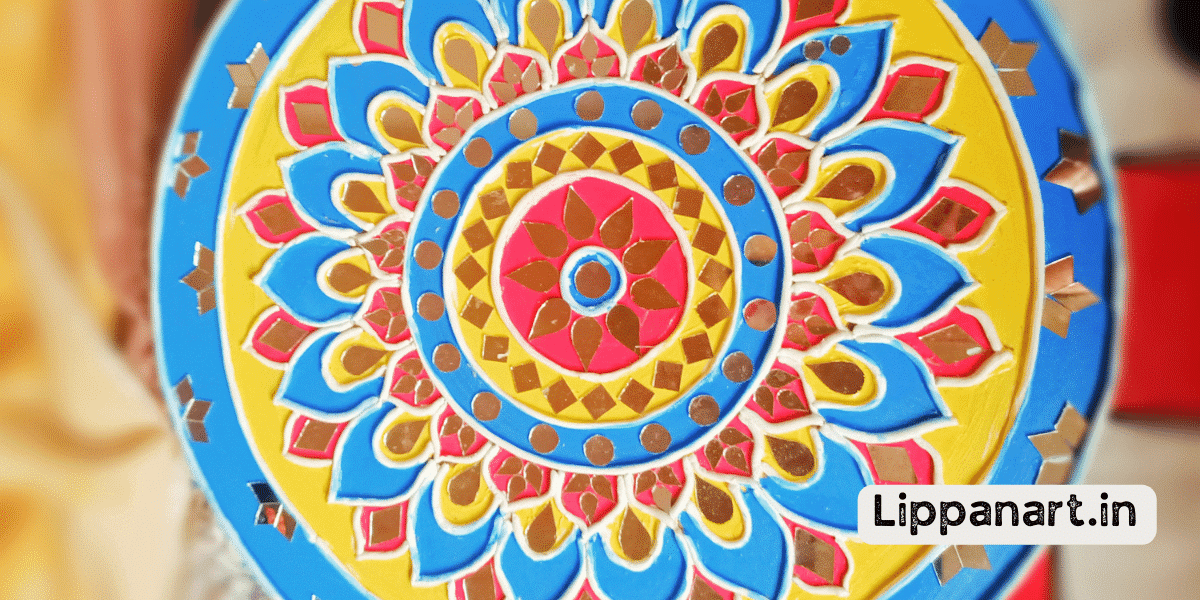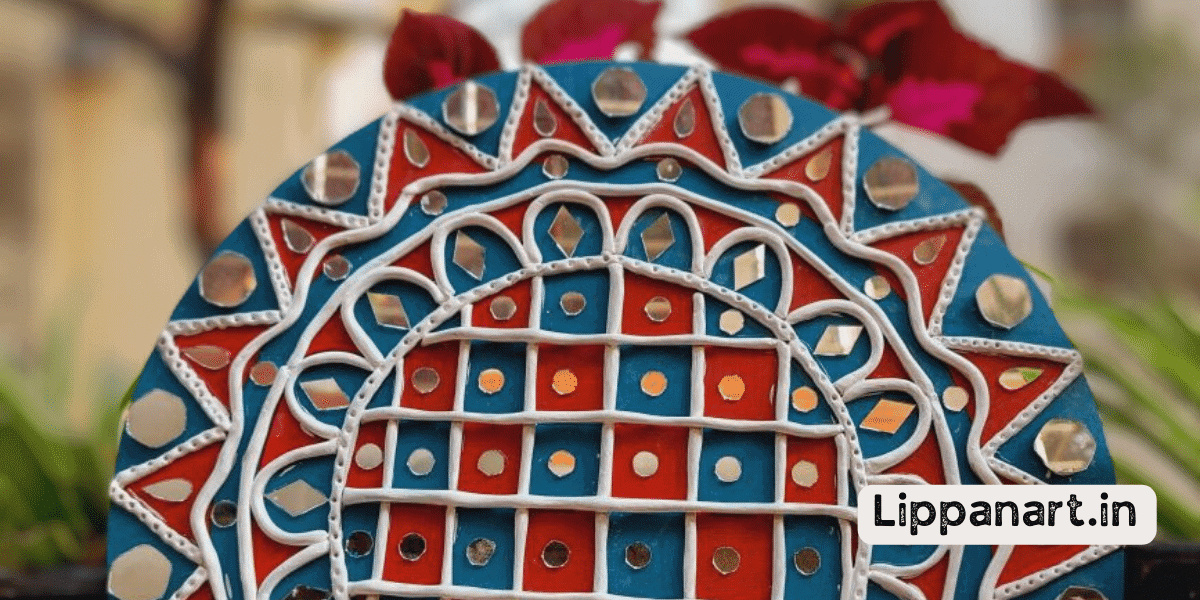You’ve probably heard of lippan kaam, a traditional Indian art form. It’s a centuries-old technique of decorating walls and objects with intricate and colourful geometric patterns. This art form is associated with Gujarat’s nomadic and rural communities and expresses their cultural heritage.
Lippan kaam is still practised and gaining popularity in modern interior design. Its vivid colours, texture, and geometric patterns make it ideal for a unique and dynamic look.
This type of art is a fusion of traditional techniques and modern design. The traditional lippan kaam process involves painstakingly layering small pieces of cloth, paper, or shells on top of each other to create a flat, mosaic-like surface. Newer techniques involve using adhesive to create the same effect. Whether for a wall or furniture, the result is always a stunning, bespoke, and eye-catching piece of art.
Lippan kaam is a great way to add a touch of the old world to any space. Its exquisite patterns and rich colours bring a sense of vibrancy to any room. It’s versatile, durable, and requires no special tools or knowledge to create. It’s perfect for anyone looking to add a unique, expressive, and timeless element to their interior design.
The History and Origins of Lippan Kaam
Y’all might be wondering where this art form came from. Well, lippan kaam is an Indian art form that dates back centuries and is still used in interior design today. It’s a tradition that’s believed to have originated in the state of Gujarat, India.
The art form uses mirrors, clay, and other materials to create intricate wall patterns. The designs are then filled with clay or a combination of coloured clay and mirrors. This technique has been used for centuries to decorate walls and create ornamental patterns.
The art form has been adapted and incorporated into modern interior design, creating unique works of art that bring a home to life. Lippan kaam is a great way to bring a unique and eye-catching design to any room. It’s also a great way to bring a bit of culture and tradition into a modern space. The intricate patterns and use of mirrors create a captivating effect that will make any room stand out.
Lippan kaam is an art form that continues to grow in popularity to bring a modern yet traditional look to any room. It’s a great way to bring a bit of culture and tradition into a modern space while creating unique, eye-catching designs. So, if you’re looking for something unique and special to bring to your space, consider lippan kaam!
Traditional Techniques and Materials Used in Lippan Kaam
Using various traditional techniques and materials, lippan kaam is an art form that creates intricate, ornamental designs on walls. This centuries-old craft is a distinctive and modern way to add beauty and value to your home.
From the use of motifs to the selection of materials, the lippan kaam process is steeped in tradition.
Traditional Techniques
- Stencilling: Craftsmen use stencils as a guide to creating intricate designs.
- Embossing: A raised effect is achieved by pressing clay onto wet cow dung.
- Stippling: Small dots are used to create patterns with a paintbrush or a stylus.
Materials Used
- Natural Dyes: Natural dyes such as turmeric and indigo add colour.
- Clay is mixed with water and cow dung to create a paste.
- Stencils: Stencils are made from paper, cloth, or metal to create intricate designs.
Traditional Motifs
- Floral: Flowers, vines, and leaves are often featured in lippan kaam designs.
- Geometrical: Squares, circles, and triangles create symmetrical patterns.
- Abstract: Abstract shapes and symbols are used to represent ideas and beliefs.
Lippan kaam is a beautiful craft deeply rooted in traditions and can be used to create stunning, one-of-a-kind works of art. It is an innovative way to bring a unique touch to any space.
Lippan Kaam in Modern Interior Design
Bringing a unique touch to any space, lippan kaam is a centuries-old craft now used to give modern interior design a distinctive and ornamental look. Popular in India, lippan kaam is an ancient art of creating intricate designs with mud and other natural materials. This traditional craft has gained popularity in modern interior design, bringing a sense of community and culture to any space.
| Modern Materials | Traditional Techniques |
|---|---|
| Clay | Mud Plastering |
| Glass | Stencils |
| Metals | Stamp Carving |
| Vegetable Dyes | Embroidery |
By incorporating modern materials into traditional techniques, lippan kaam adds a unique dimension to modern interior design. When used in a creative way, lippan kaam can transform any room into a beautiful and ornamental space. From murals to furniture designs, lippan kaam is an excellent way to bring character and beauty to any space.
Lippan kaam is a traditional craft with modern applications. Combining traditional techniques with modern materials, lippan kaam can give any space a unique and ornamental look. This centuries-old craft is a great way to bring culture, community, and creativity into any interior design.
The Resurgence of Lippan Kaam in Contemporary Design
You can now see the lippan team’s resurgence in contemporary design, adding a unique touch of culture and creativity to any space. This traditional form of art, from Gujarat, India, is characterised by intricate and vibrant patterns and is often used to adorn walls, furniture, and other objects. Its modern usage is an innovative way to bring a classic flair to any home or office.
Materials:
- Crafted from clay and mirrors, lippan kaam is easy to bring texture and depth to a room.
- The art can be customised to fit any space using natural materials such as wood, fabric, and paper.
- Colourful paints and dyes can add a unique, vibrant touch.
Design:
- The Lippan kaam pattern effectively creates a focal point and draws attention to specific areas.
- Bold and intricate designs can energise a room or create a calming atmosphere.
- The art can also be combined with other traditional elements, such as pottery and sculptures, for a truly unique look.
Impact:
- Incorporating lippan kaam into a space can bring a sense of culture and authenticity.
- Art is a way to express yourself, showcasing your creativity and unique identity.
- Adding this type of art to your interior design can bring sophistication and beauty to your space. Lippan kaam provides a unique and exciting way to incorporate culture and creativity into modern interior design. Its intricate patterns and vibrant colours can be used to create a stunning visual effect. In contrast, its traditional materials can bring a classic feel to a contemporary setting.
- Editor’s Choice
- Best Seller
- Amazon Choice
Innovative Applications of Lippan Kaam in Interior Design
Explore the possibilities of incorporating the intricate patterns and vibrant colours of lippan kaam into your interior to create a truly unique look.
This traditional Indian craft dates back centuries and can be used innovatively to bring a touch of culture and heritage to a contemporary home.
For example, mud walls with geometric motifs can be adorned with lippan kaam to add texture, depth, and complexity to the overall decor.
For a more modern take, you can combine traditional lippan kaam with contemporary materials such as metal or glass to create eye-catching art pieces that hint at the past and present.
From intricate wallhangings to decorative accents, lippan kaam is a versatile material that can create a unique aesthetic.
Lippan kaam is an ideal way to bring a touch of culture and heritage into your home. Its vibrant colours, intricate patterns, and timeless beauty make it a perfect addition.
The Impact of Lippan Kaam on Aesthetics and Atmosphere
Incorporating lippan kaam into interior designs can dramatically impact a space’s aesthetics and atmosphere. This traditional Indian art form, which often includes mud work designs, is deeply rooted in culture and history and uniquely creates an atmosphere of warmth and charm.
Using lippan kaam in interior design can:
Enhance Aesthetics:
- Create visually appealing patterns
- Add captivating texture to walls
- Enhance the overall look and feel of a space
Create Atmosphere:
- Create a feeling of comfort and security
- Add an element of tradition and culture
- Make a space inviting and cosy
Increase Value:
- Increase the value of a property
- Create a unique, timeless design
- Make a space stand out from the crowd
Lippan kaam is an ancient art form that adds a beautiful, unique touch to any interior design. By incorporating this timeless craft, designers can create a space that is aesthetically pleasing, emotionally resonant, and sure to increase the value of any property.
Lippan Kaam is a Sustainable and Eco-Friendly Design Choice
Using lippan kaam in your decor can be an eco-friendly and sustainable design choice. Its intricate form and texture add a unique aesthetic to any space while at the same time being an environmentally conscious choice.
Lippan kaam comprises natural, locally sourced materials, like clay, mud, and straw, requiring little energy. This means that the environmental footprint is kept to a minimum. Plus, the materials used are biodegradable and easily recyclable, making it an excellent option for those who are looking for a form of decor that is both sustainable and eco-friendly.
Not only does lippan kaam help reduce your environmental impact, but it also adds a touch of culture and tradition to your space. The intricate patterns and designs of lippan kaam bring a sense of history and artistry to any room, making it an excellent choice for those looking for an innovative and unique design.
The Cultural Significance of Lippan Kaam in Interior Design
Adding lippan kaam to your decor not only allows you to reduce your environmental impact but also brings a sense of culture and tradition into your home.
The traditional mural craft of lippan kaam is deeply rooted in everyday life of many families in India, especially in the state of Gujarat. It is a mud-relief work of aesthetic perfection made with vibrant colours and clay to combat the region’s harsh climate.
Lippan kaam – kutch, the not-so-known lippan art, is an odour lippan kaam, an animal form art form made with sticks and clay. It is becoming a popular choice for modern house design, as custom home décor in modern homes and is being embraced by the millennial community who appreciate traditional art forms.
The main ingredients for lippan kaam are camel and cow dung, which gives it a unique appeal. The art is mostly geometrical, with complex bas-relief and decorative motifs. It is often used to decorate walls with graphic and eye-catching geometric patterns, precise patterns, and diamond-shaped mirrors. The mud mirror art is a folk tradition still alive and vibrant in Gujarat.
The circular homes, known as bhungas, house families in the Kutch region of Gujarat decorated with lippan kaam. It is also becoming a popular choice for modern marketplaces and online craft stores for those looking for unique and lively décor for their homes.
With lippan kaam, the peepul tree, and other traditional motifs, you can bring a piece of the vibrant culture of Gujarat to your home.
Frequently Asked Questions
What Level of Expertise Is Required to Create a Lippan Kaam Design?
Creating a lippan kaam design requires a certain level of expertise. You’ll need creativity to come up with unique ideas and attention to detail to ensure the design looks flawless. Innovative thinking is also key, as this will help you to create something truly special.
Are There Any Health Benefits Associated With the Use of Lippan Kaam?
Discover the delightful health benefits of using lippan kaam! From stimulating creativity to reducing stress, enjoy the unique and innovative experience of lippan kaam to improve your well-being.
What Is the Best Way to Preserve the Integrity of a Lippan Kaam Design?
Preserve the integrity of a lippan kaam design by choosing durable and long-lasting materials. One should consider investing in high-quality items and implementing careful techniques to create a design that will endure the passage of time. Innovate with your approach for a timeless, unique look.
Conclusion
You’ve seen how lippan kaam is making a major comeback in modern interior design. With its traditional techniques, unique materials, and beautiful aesthetics, it’s easy to see why this traditional Indian art form is having such a resurgence.
Not only is it aesthetically pleasing, but it’s also eco-friendly and has a lot of cultural significance. With its ability to add a unique charm to any space, it looks like lippan kaam is here to stay – an example of how traditional art forms can withstand the test of time!














